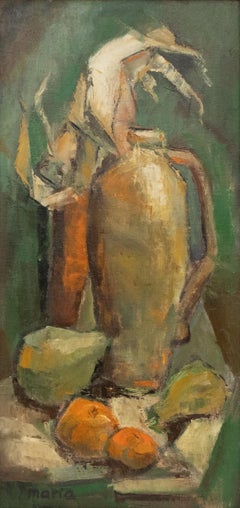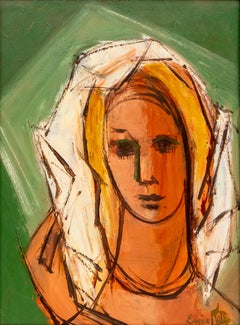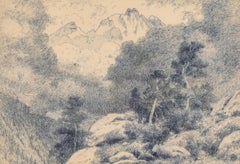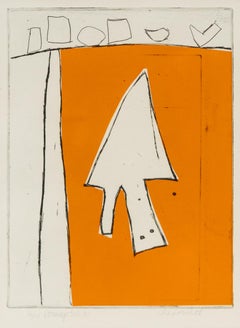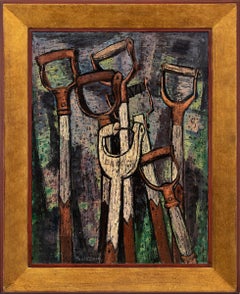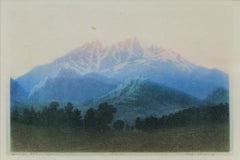David Cook Galleries
to
92
303
172
59
34
33
29
28
28
27
21
20
14
13
7
7
4
3
2
2
1
27
19
15
9
8
Early 20th-Century Still Life Oil Painting – Bottles & Fruit, Framed Artwork
Located in Denver, CO
Enhance your collection with "Still Life (#10)", an exquisite early 20th-century oil painting by renowned artist Maria Lowenstein. This semi-abstract still life masterfully captures ...
Category
Early 20th Century American Impressionist Still-life Paintings
Materials
Oil
Modernist Woman Portrait - Original Acrylic Painting with Rich Green Background
Located in Denver, CO
Discover a striking original modernist portrait by Eunice Katz (1927–2008). This captivating acrylic painting on board features a woman’s portrait, rendered in a bold palette of rich...
Category
Mid-20th Century American Modern Portrait Paintings
Materials
Acrylic
Storm in the Rockies, Colorado Mountain Landscape, Plein Air Ink Field Drawing
By Charles Partridge Adams
Located in Denver, CO
Own a rare, original vintage field study drawing by renowned Colorado artist Charles Partridge Adams. This atmospheric ink-on-paper composition captures the raw beauty of a storm swe...
Category
Early 20th Century American Impressionist Landscape Drawings and Waterco...
Materials
Ink
Homage to E.W. (Emerson Woelffer), Original Mid Century Modern Lithograph
Located in Denver, CO
Discover a stunning vintage original lithograph by renowned Colorado Springs artist Mary Chenoweth. This striking abstract composition features bold geometric shapes set against a vi...
Category
Mid-20th Century Abstract Abstract Prints
Materials
Lithograph
Shovel Handles, 1950s Framed American Modernist Oil Painting, Green Bronze Blue
By Paul Kauvar Smith
Located in Denver, CO
"Shovel Handles" is an original 1953 semi-abstract modernist oil painting on board by renowned Denver artist Paul K. Smith (1893-1977). This captivating piece showcases Smith’s signa...
Category
1950s American Modern Figurative Paintings
Materials
Oil
Longs Peak, Estes Park, Colorado, No. 2, Original 1920s Aquatint
By George Elbert Burr
Located in Denver, CO
This original vintage color aquatint etching captures the breathtaking beauty of Longs Peak and Mount Meeker, as seen from Rocky Mountain National Park near Estes Park, Colorado. Cre...
Category
1920s American Impressionist Landscape Prints
Materials
Aquatint
Datura Stramonium, 20th Century Still Life Watercolor with Flowers in a Vase
By Werner Drewes
Located in Denver, CO
This original vintage watercolor painting, titled "Datura Stramonii," is a stunning work by renowned American abstractionist Werner Drewes. The composition captures the delicate beau...
Category
Mid-20th Century American Impressionist Still-life Drawings and Watercolors
Materials
Watercolor
Ex Voto; Miraculous Intervention of a Difficult Pregnacy, 19th Century Retablo
Located in Denver, CO
This authentic 19th-century Mexican ex-voto is a powerful testament to faith and survival, painted in oil on tin with ink circa 1869 by an anonymous Mexican artist. It is elegantly d...
Category
1860s Folk Art Interior Paintings
Materials
Metal
Ex Voto Holy Tribute for the Healing of a Son, 1940s Ink & Paint Metall Retablo
Located in Denver, CO
This authentic Mexican ex-voto is a heartfelt tribute of gratitude, painted in oil on tin with ink circa 1940 by an anonymous Mexican artist. It is beautifully framed in a hand-carve...
Category
1940s Folk Art Figurative Paintings
Materials
Metal
"Birth" 1940s Surrealist Abstract Watercolor Painting, Gray Scale Female Figure
By Charles Ragland Bunnell
Located in Denver, CO
"Birth" is a striking semi-abstract watercolor painting created by the talented Colorado artist, Charles Ragland Bunnell, in 1943. The artwork, crafted during Bunnell's Black and Blu...
Category
1940s Surrealist Figurative Paintings
Materials
Watercolor
Sky (Biplane Flying Over Water), Mid Century Modern Mixed Media Composition
Located in Denver, CO
Discover a rare and original mixed media collage by renowned Colorado Springs artist Mary Chenoweth (1918-1999). This unique composition features a striking image of a biplane soarin...
Category
1990s Abstract Mixed Media
Materials
Acrylic
Lush Grazing, North Park (Colorado) Rocky Mountain Landscape Oil Painting
By James Emery Greer
Located in Denver, CO
Immerse yourself in the breathtaking beauty of the Rocky Mountains with Lush Grazing, North Park, an original oil painting by renowned landscape artist James Emery Greer, created in ...
Category
Mid-20th Century Abstract Impressionist Landscape Paintings
Materials
Oil
Logarithmic Spiral #2 – 1970s Original Abstract Geometric Oil Painting
Located in Denver, CO
Step into the captivating world of mathematical beauty and artistic precision with Logarithmic Spiral #2, an original 1970s oil painting on board by Pueblo, Colorado artist Chase Var...
Category
1970s Abstract Geometric Abstract Paintings
Materials
Oil
1940s Impressionist Oil Painting – Three Bathing Female Figures, Original Art
Located in Denver, CO
Step into a world of serenity and natural beauty with "Three Bathers," a captivating vintage 1940s oil painting on board by renowned Colorado artist Morgan Wagner. This exquisite art...
Category
1940s American Impressionist Portrait Paintings
Materials
Oil
North Table Mountain (Landscape near Golden, Colorado), Early 20th Century Oil
By Robert Alexander Graham
Located in Denver, CO
Transport yourself to the picturesque landscapes of Golden, Colorado, with this breathtaking vintage oil painting on canvas by acclaimed artist Robert Alexander Graham. Dating back t...
Category
1920s American Impressionist Landscape Paintings
Materials
Oil
1930s WPA Era Watercolor Painting of Horses in a Southwest Landscape
By Lloyd Moylan
Located in Denver, CO
Immerse yourself in the beauty of the American Southwest with this stunning vintage painting by renowned artist Lloyd Moylan (1893–1963). This masterful watercolor and gouache on pap...
Category
1930s American Modern Animal Drawings and Watercolors
Materials
Gouache, Watercolor
Mid-Century Modern Abstract Sailboat Art – Mixed Media Charcoal & Ink Drawing
By Janet Lippincott
Located in Denver, CO
Discover a stunning mid-century modern abstract sailboat composition by renowned 20th-century artist Janet Lippincott (1918–2007). This one-of-a-kind mixed media piece, created with ...
Category
Mid-20th Century Abstract Expressionist Abstract Drawings and Watercolors
Materials
Charcoal, Ink
Trees in Ranchitos II, New Mexico, 1970s Color Lithograph Landscape with Trees
By Andrew Michael Dasburg
Located in Denver, CO
"Trees in Ranchitos II" is a stunning 1975 color lithograph by renowned modernist artist Andrew Michael Dasburg (1887-1979). This collectible artwork, initialed in the lower right, captures the serene beauty of the New Mexico landscape, reflecting Dasburg’s signature blend of Post-Impressionism and Cubist influences. Presented in a custom frame measuring 30 ½ x 36 ¼ inches. Image size is 16 ½ x 23 ¼ inches.
About the Artist:
Born France, 1887
Died New Mexico, 1979
Born in Paris, France, Andrew Dasburg immigrated to New York City in 1892, where his talent was recognized early. He studied at the Art Students League of New York, training under Robert Henri, Kenyon Cox, and Birge Harrison.
In 1908, Dasburg traveled to Paris, where he encountered the works of Henri Matisse and Paul Cézanne, igniting his lifelong passion for modernism. He later settled in Woodstock, NY, immersing himself in the avant-garde art scene alongside Morgan Russell...
Category
1970s American Modern Landscape Prints
Materials
Lithograph
Mt. Evans Colorado Mountain Landscape – Painterly Impressionist Oil Painting
Located in Denver, CO
Experience the breathtaking beauty of Mt. Evans, Colorado, through this stunning original oil painting by renowned artist Ferdinand Kaufmann (1864–1942). Created circa 1920–1940, thi...
Category
1920s American Impressionist Landscape Paintings
Materials
Oil
Garden of the Gods Nightscape – Original American Modernist Landscape Painting
By Sushe Felix
Located in Denver, CO
Immerse yourself in the breathtaking beauty of Garden of the Gods with this stunning original pastel drawing by renowned Colorado artist Sushe Felix. Set against a dramatic nighttime...
Category
1980s American Modern Landscape Drawings and Watercolors
Materials
Oil Pastel
Jenny Lake, Estes Park – 1950s Mid-Century Rocky Mountain Landscape Oil Painting
Located in Denver, CO
Immerse yourself in the breathtaking beauty of the Rocky Mountains with this stunning mid-century oil painting by renowned artist Clarence Durham. Capturing the tranquil waters of Jenny Lake...
Category
1950s American Impressionist Landscape Paintings
Materials
Oil
Rocky Shore – 1960s Abstract Seascape Oil Painting in Vibrant Green & Blue Tones
Located in Denver, CO
Experience the energy and beauty of the coastline in Rocky Shore (1967), a stunning original oil painting on canvas by acclaimed artist Ann Sink (1924-2019). This vibrant abstract se...
Category
1960s Abstract Expressionist Abstract Paintings
Materials
Oil
Original Impasto Abstract Mid-Century Modern Oil Painting, Framed Blue & Red Art
Located in Denver, CO
Experience the bold elegance of Wilma Fiori's original abstract oil painting, a striking composition by the renowned Denver artist (1929-2019). This mid-century modern masterpiece fe...
Category
Mid-20th Century Abstract Expressionist Abstract Paintings
Materials
Oil
Sheep, Storm, South Park, Colorado (Sheep grazing on a Colorado plain)
By Myron Wood
Located in Denver, CO
Capture the timeless beauty of the American West with this vintage 1960s photograph by renowned photographer Myron Wood. Titled "Sheep, Storm, South Park, Colorado", this stunning bl...
Category
1960s American Modern Black and White Photography
Materials
Photographic Film
1950s Signed New Mexico Winter Lithograph – Original Vintage Snowy Landscape Art
By Kenneth Miller Adams
Located in Denver, CO
Step into the serene beauty of a New Mexico winter with this stunning 1950s signed lithograph, New Mexico Village Under Snow, by acclaimed artist Kenneth Miller Adams. This rare vint...
Category
1950s American Modern Landscape Prints
Materials
Lithograph
The Train, Vintage Vibrant Folk Art Oil Painting with Bold Colorful Details
By Martin Saldana
Located in Denver, CO
Discover the vibrant world of Martin Saldana, a talented Mexican-American folk artist known for his captivating rustic and naïve style. This original painting, titled "The Train", wa...
Category
1950s Folk Art Abstract Paintings
Materials
Oil
Angle of Repose, Minimalist Abstract Landscape Oil Painting - Contemporary Art
Located in Denver, CO
"Angle of Repose" is a striking abstract minimalist landscape created by contemporary artist Walter Nelson. This compelling oil painting captures a bold, yet serene composition: a bl...
Category
2010s Abstract Impressionist Abstract Paintings
Materials
Oil
Original 1980s Tree Mixed Media Acrylic Collage Painting, Vibrant Nature Artwork
Located in Denver, CO
This vintage 1980s original semi-abstract painting by acclaimed Colorado Springs artist Mary Chenoweth features a striking portrayal of three trees set against a bold, abstracted landscape. The composition is defined by vibrant orange, red, brown, and blue lines, creating a sense of movement and depth within the piece. The acrylic paint is thoughtfully combined with newspaper collage, adding texture and an intriguing mixed media element that enhances the artwork’s visual appeal.
The painting is signed by Mary Chenoweth in the lower left corner, ensuring its authenticity as a unique piece of art. It is beautifully presented in a custom white float frame, which measures 31.25 x 42.75 x 2 inches, with the image size at 30.25 x 42.25 inches. This elegant framing enhances the painting's bold colors and contemporary style, making it a standout addition to any collection.
Ideal for art collectors, lovers of abstract nature art, or those drawn to vibrant mixed media creations, this piece captures the essence of the natural world through a modern, expressive lens. Mary Chenoweth’s work reflects her deep connection to the environment and her innovative use of materials, making this artwork a timeless reflection of her creative vision.
Perfect for adding a unique and colorful touch to your home or office space, this semi-abstract tree painting...
Category
1980s American Modern Mixed Media
Materials
Acrylic, Newsprint
Colorado Mining Town, Early Sunday Morning - Modernist Mountain Landscape
By Paul Kauvar Smith
Located in Denver, CO
This captivating original mountain landscape by the talented Paul K. Smith brings to life the beauty and historical charm of Colorado’s mining heritage. Painted in the 1930s-1950s, the artwork likely depicts one of Colorado's iconic historic mining towns...
Category
1930s American Modern Landscape Paintings
Materials
Oil
Colorado Landscape, Rocky Mountains in Autumn, 20th Century Oil Painting
By Raphael Lillywhite
Located in Denver, CO
This stunning autumn mountain landscape by renowned artist Raphael Lillywhite captures the breathtaking beauty of Colorado’s rugged terrain. Painted in the traditional plein air styl...
Category
1920s American Realist Landscape Paintings
Materials
Oil
Original Mid-Century Modern Abstract Gouache Painting by Taos Artist Louis Ribak
By Louis Ribak
Located in Denver, CO
Experience the bold elegance of Louis Leon Ribak's original mid-century modern abstract painting, a striking composition by the renowned Taos, New Mexico artist. This captivating gou...
Category
Mid-20th Century Abstract Abstract Paintings
Materials
Gouache
The Passing Parade, 20th Century Lithograph, Southwestern Desert with Antelope
By Ila Mae McAfee
Located in Denver, CO
This stunning original lithograph, titled The Passing Parade, is a signed piece by renowned American artist Ila Mae McAfee (1897-1995). Created in the 20th century, the artwork depic...
Category
20th Century American Modern Animal Prints
Materials
Lithograph
1960s Mid Century Modern Desert Landscape Acrylic Painting in Rich Earth Tones
Located in Denver, CO
This captivating 1960s abstract painting, titled "Desert Landscape," is a striking original work by acclaimed New Mexico and Colorado artist Ann Sink. The composition beautifully cap...
Category
1960s Abstract Expressionist Abstract Paintings
Materials
Acrylic
1985 Original Abstract Watercolor Painting – Monochrome Black & White Modern Art
By Ynez Johnston
Located in Denver, CO
This captivating 1985 abstract painting by Colorado Springs artist Ynez Johnston masterfully combines watercolor and gouache on paper, creating a striking monochrome composition. Fea...
Category
1980s Abstract Expressionist Abstract Drawings and Watercolors
Materials
Watercolor, Gouache
1940s WPA Era American Modern Colorado Mountain Landscape Watercolor Painting
Located in Denver, CO
This original watercolor painting by American artist Edgar Britton captures the serene beauty of a Colorado mountain landscape. Created in 1946, this piece showcases soft, airy tones...
Category
1940s American Modern Landscape Drawings and Watercolors
Materials
Watercolor
Moonrise Over Colorado Springs: 1950s Abstract Oil Painting Green, Blue & Ochre
By Charles Ragland Bunnell
Located in Denver, CO
"Moonrise Over Colorado Springs" is a striking 1950s abstract expressionist oil painting by renowned artist Charles Ragland Bunnell. Created in 1952, this captivating piece features ...
Category
1950s Abstract Abstract Paintings
Materials
Oil
Rebound Series #2: 1980s Abstract Oil Painting with Polygons in Earth Tones
By Eugene Bavinger
Located in Denver, CO
"Rebound Series #2" by Oklahoma artist Eugene Allen Bavinger is a captivating abstract geometric painting that showcases a harmonious blend of soft, muted tones. This composition fea...
Category
1980s Abstract Abstract Paintings
Materials
Oil
Melting Snow: 1930s Oil Painting of Colorado Landscape with Creek & Mountains
By Robert Graham
Located in Denver, CO
"Melting Snow," a vintage original oil painting from the 1920s-1930s, beautifully captures a serene Colorado winter landscape. The scene features a snow-covered creek winding through...
Category
1920s American Impressionist Landscape Paintings
Materials
Oil
In Glacier Park: 1920s Original Oil Painting of Glacier National Park, Montana
By Nellie Augusta Knopf
Located in Denver, CO
"In Glacier Park," an original oil painting by renowned artist Nellie Augusta Knopf, captures the serene beauty of Glacier National Park in Montana. This stunning piece depicts a pea...
Category
1920s American Impressionist Landscape Paintings
Materials
Oil
Vibrant Geometric Abstract with Circles - Mid 20th Century Oil Painting Artwork
Located in Denver, CO
This striking vintage 20th-century abstract painting, created by talented Colorado Springs artist Mary Chenoweth, offers a dynamic geometric design highlighted by bold, vibrant circl...
Category
Mid-20th Century Abstract Geometric Abstract Paintings
Materials
Oil
Original Signed 1970s Blue Birds Colored Lithograph - Mid Century Modern Artwork
Located in Denver, CO
This vintage original lithograph by renowned artist Mary Chenoweth features an abstract depiction of birds in flight, showcasing her unique technique of layering various textures of ...
Category
1970s American Modern Animal Prints
Materials
Lithograph
1935 Snowy Town Grove Winter Landscape Oil Painting - Vintage Winter Art
By Robert Amick
Located in Denver, CO
This original circa 1935 oil painting by acclaimed Colorado artist Robert Wesley Amick captures a serene winter scene in a quiet town grove. The composition depicts a peaceful moment...
Category
1930s American Impressionist Landscape Paintings
Materials
Oil
1920s Pastel-Toned Oil Painting of Aspen & Craig Meadows in Spring, Colorado
Located in Denver, CO
"Aspen, Craig Meadows in Spring" is a circa 1920 original oil painting by renowned artist Albert Stokes Bancroft. This stunning landscape captures the vibrant beauty of Craig Meadows...
Category
1920s American Impressionist Landscape Paintings
Materials
Oil
1953 Signed Black & White Etching Print 'Ceremonial Day at Taos' New Mexico
By Gene Kloss
Located in Denver, CO
"Ceremonial Day at Taos" is a captivating vintage black and white etching by renowned American artist Gene Kloss. Created in 1953, this drypoint etching depicts the vibrant life of T...
Category
1950s American Modern Landscape Prints
Materials
Etching
Rays - 1975 Abstract Geometric Acrylic Painting in Violet, Orange & Cerulean
Located in Denver, CO
"Rays" is an original abstract colorist painting by the renowned artist and filmmaker Victor Atkins. This striking work features geometric strips of vivid color, masterfully arranged...
Category
1970s Abstract Geometric Abstract Paintings
Materials
Acrylic
Mobile by Alexander Calder (O'Keeffe at Abiquiu), Myron Wood Photograph
By Myron Wood
Located in Denver, CO
This stunning black and white photograph by renowned photographer Myron Wood captures the iconic mobile by Alexander Calder at Georgia O'Keeffe's Abiquiu home in April 1980. The imag...
Category
1980s American Modern Black and White Photography
Materials
Photographic Film
Mid-Century Abstract Mixed Media 'Transfiguration' Composition with Marble Dust
By Pawel Kontny
Located in Denver, CO
"Transfiguration" is a captivating original abstract painting by the talented artist Pawel Kontny (also known as Paul Kontny), created during the mid-20th century. This unique composition was crafted using a combination of marble dust, gesso, and oil glaze on masonite, resulting in a striking raised texture that adds depth and dimension to the artwork. The use of marble dust and gesso gives the piece a rich, tactile quality, making it visually stunning.
The painting is rendered in a harmonious palette of neutral tones, including shades of brown, beige, yellow, and grey, creating a subtle yet powerful interplay of light and shadow. These muted hues evoke a sense of calm and contemplation, allowing the viewer to immerse themselves in the abstract forms and textures that dominate the canvas.
This piece is presented in its original black and gold frame, which enhances its vintage charm and complements the sophisticated color palette. "Transfiguration" is an exceptional work of art, perfect for collectors of mid-century abstract art...
Category
1960s Abstract Mixed Media
Materials
Marble
Original Winter Trees Landscape Watercolor - Rocky Mountains, Early 20th Century
By Charles Partridge Adams
Located in Denver, CO
This original early 20th-century watercolor is by Charles Partridge Adams (1858–1942), a celebrated American artist known for his exceptional depictions of the Colorado landscape and...
Category
Early 20th Century American Impressionist Landscape Drawings and Waterco...
Materials
Watercolor
Vibrant Original Acrylic Painting 'Rainy Day' Interior Scene with Woman Reading
By Louis Recchia
Located in Denver, CO
"Rainy Day" is a captivating original acrylic painting on canvas, enhanced with dimensional wood pieces for a unique textured effect. This stunning figurative artwork, influenced by ...
Category
1980s Folk Art Interior Paintings
Materials
Wood, Acrylic
Maine Coast, Original Seascape Oil Painting, 1930s Impressionist Painting
By James Emery Greer
Located in Denver, CO
"Maine Coast" is a breathtaking, original oil painting by renowned American artist James Emery Greer (1903-1990), created during the 1980s. This exquisite seascape beautifully captu...
Category
1980s American Impressionist Landscape Paintings
Materials
Oil
Man In His Search for God, 1939 WPA Era Original Grey Scale Gouache Painting
By Charles Ragland Bunnell
Located in Denver, CO
This striking vintage 1939 original painting, titled Man In His Search for God, is a powerful piece from Charles Bunnell’s renowned Black and Blue Series. The artwork is painted in i...
Category
1930s Futurist Figurative Paintings
Materials
Gouache
Battered by Wind and Storms, Sangre de Cristos Mountain Oil Painting, Colorado
By James Emery Greer
Located in Denver, CO
This breathtaking original oil on canvas painting by James Emery Greer (1903-1990), titled Battered by Wind and Storms, Sangre de Cristos, offers a striking depiction of Southern Col...
Category
1980s American Realist Landscape Paintings
Materials
Oil
1890s Traditional Mountain Fall Landscape Oil Painting of Clear Creek, Colorado
By Charles Partridge Adams
Located in Denver, CO
This stunning 1890 oil painting captures the breathtaking beauty of Clear Creek, Colorado, with its serene river, majestic mountains, and vibrant autumn foliage. Created by Charles P...
Category
Late 19th Century American Impressionist Landscape Paintings
Materials
Oil
Riding the Brahmas (Man Riding a Bull) - Signed Original 20th Century Lithograph
By Ethel Magafan
Located in Denver, CO
This original modernist lithograph, titled Riding the Brahmas, is a dynamic work by esteemed Colorado artist Ethel Magafan. The lithograph depicts a dramatic scene of a man riding a ...
Category
Mid-20th Century American Modern Animal Prints
Materials
Lithograph
1960s Abstract Serigraph in Gray, Black, White with Red Moon, Vintage Modern Art
By Thomas W. Benton
Located in Denver, CO
This striking vintage original serigraph, created by renowned Aspen artist Thomas Whelan Benton, features a bold composition of a white snowflake set against a dramatic black field, ...
Category
1960s Abstract Abstract Prints
Materials
Screen
Original 1970s Abstract Floral Oil Painting, Red & Earth Tones, Mid-Century Art
Located in Denver, CO
This stunning vintage semi-abstract oil painting, created by Lawrence Harris (also known as Larry Harris), showcases a captivating composition of red f...
Category
1970s Abstract Abstract Paintings
Materials
Oil
"Bird #2" - 1949 Vintage Black & White Modernist Monotype Print by Edgar Britton
Located in Denver, CO
Bird #2 is a striking vintage black-and-white monotype print by renowned Colorado artist Edgar Britton. Created in 1949, this original work features a bold composition of a white dov...
Category
1940s American Modern Animal Prints
Materials
Monotype
Original Vibrant Vintage Abstract Monotype Print – Pink, Grey, Yellow on Paper
Located in Denver, CO
This striking abstract monotype painting, created by 20th-century Colorado artist Wilma Fiori (1929-2019), showcases her exceptional mastery of color and form. The artwork features v...
Category
Late 20th Century Abstract Abstract Paintings
Materials
Paper, Monotype
1924 Colored Pencil Drawing by George E Burr, Arizona Desert Storm Landscape
By George Elbert Burr
Located in Denver, CO
This vintage, original colored pencil drawing titled Untitled (Storm over Desert Landscape, Arizona) was created in 1924 by celebrated American artist George ...
Category
Early 20th Century American Impressionist Landscape Drawings and Waterco...
Materials
Color Pencil, Paper
Original 1940s Retrofuturism Gouache Painting 'Birth of Mind' in Black & White
By Charles Ragland Bunnell
Located in Denver, CO
This vintage 1940s gouache painting, titled Birth of Mind, is a striking example of retrofuturism by Charles Ragland Bunnell, a prominent artist from the Broadmoor Academy...
Category
1940s Futurist Abstract Drawings and Watercolors
Materials
Gouache
